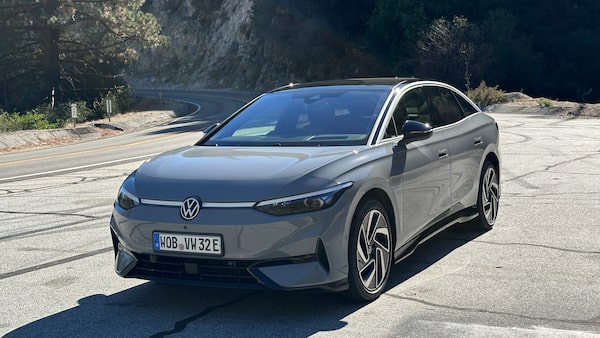
The ID.7 has Volkswagen's new design language with its sculpted hood and rounded edges.Mark Richardson/The Globe and Mail
On paper, the new Volkswagen ID.7 looks like nothing special. It’s a large and expensive fully electric sedan with a decent range and quick recharging times. Acceleration stats aren’t swift, though, and it’s just another car with hardly any physical control buttons.
But give it a while and it might grow on you. The ID.7 is VW’s second generation of ID electric vehicles and it builds on what we’ve already seen with the smaller ID.4 crossover. The motor is updated to the new APP 550 unit, which is what will also power the ID.4 this coming year. I only drove the single-motor rear-wheel-drive version here in California, but there will be a more powerful dual-motor, all-wheel-drive version once the car goes on sale some time this summer.
Volkswagen calls this a sedan, though its trunk is more of a hatchback and passengers can lean over from the rear seats to reach their luggage. Those seats fold flat for extra cargo carrying, and there’s even a pass-through for skis or hockey sticks. It might look like a sedan from the outside, but it acts like a practical hatchback once you settle in.
I drove the ID.7 through some noisy Los Angeles traffic and up onto the Angeles Crest Highway, where it swung cheerfully and confidently through the tight corners. Like any all-electric vehicle, the heavy batteries are down low and the centre of gravity is close to the road, so it will drive flat around the curves. The test car was fitted with adaptive suspension, though there’s no word yet on how much that option will cost.
We don’t know the Canadian price of the new ID.7, but it will probably start in the low $70,000s. We do know that the base price of the ID.7 in Germany is €57,000 ($82,000). When you compare that to the ID.4, which starts at the equivalent of $58,000 in Germany and sells here for just over $49,000, then the numbers fall into line – but it’s still a guessing game, based on many variable factors and available options. No doubt it’ll be a big step up from the now-discontinued VW Arteon sedan, taking it close to Audi territory.
What we do know is the base edition of the ID.7 will have a 210-kilowatt motor powered by a 77-kilowatt-hour battery. That can be charged from 10 per cent to 80 per cent in 28 minutes, provided you have a Level 3 charger with a capacity of at least 175 kilowatts.
Will a ‘cheap’ EV get more Canadians to make the switch from gas?
Range is less precise because the only supplied figure at this time is the WLTP (Worldwide Harmonized Light Vehicles Test Procedure) standard, which is different from the North American EPA (Environmental Protection Agency) standard. Volkswagen claims an impressive WLTP range of 621 kilometres with an average power consumption of 16.3 – 14.1 kilowatt-hours per 100 kilometres). This suggests an EPA range of about 485 kilometres, but that’s a rough conversion.
These are all just numbers, of course, and they’ll vary widely in actual application. If you routinely charge at home, as you should, then charging speed and often range itself are much less relevant.
The truly impressive figure is the co-efficient of drag, which measures the slipperiness of the vehicle through the wind. It helps considerably that the ID.7 is a sedan, which allows it a 0.23 drag co-efficient, compared with the more brick-like ID.4 that has a 0.28.
The ID.7 is a flagship for Volkswagen, and something for the maker to be especially proud of. Even so, it’s a sign that Volkswagen is straying further from being a car of the people to being a car for people with more money than most. Let’s hope we see a smaller and more affordable electric VW soon.
Tech specs
Volkswagen ID.7
- Base price/as tested: To be announced ($70,000 estimate)
- Powertrain/battery: 210-kilowatt single motor/ 77 kilowatt-hour
- Horsepower/torque: 282 / 402 lb-ft
- Energy charging/range: 175 kilowatts / 485 kilometres (estimate)
- Alternatives: Tesla Model 3, Hyundai Ioniq6, Polestar 2, BMW i4
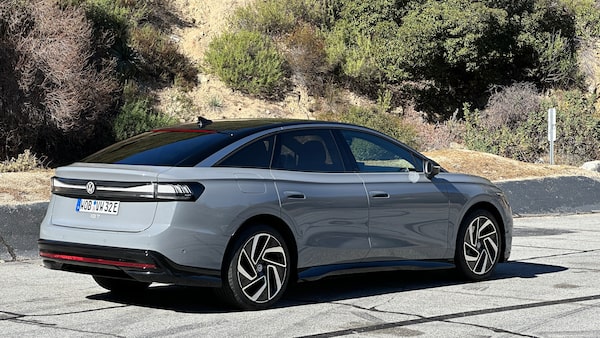
The base edition of the ID.7 will have a 210-kilowatt motor powered from a 77-kilowatt-hour battery.Mark Richardson/The Globe and Mail
Looks
There’s no mistaking the ID.7 for being anything but a Volkswagen, with its sculpted hood and rounded edges. Other German makers might term it a four-door coupe with its fastback rear end, but whatever you call it, the EV platform allows for short overhangs past the wheels, with a big 2,971-millimetre wheelbase. Slim LED lights at front and back add a modern touch, as well as the obligatory funky but aerodynamic wheel rims.
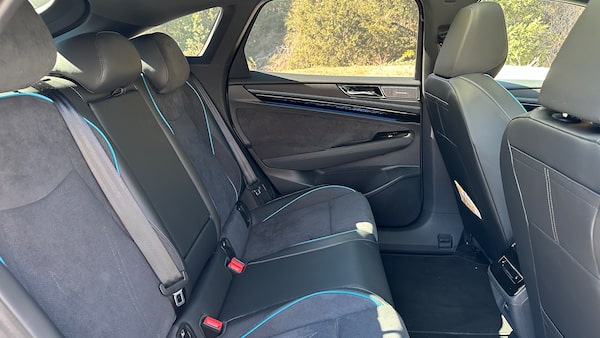
The back seats on the Volkswagen ID.7. Optional extras including the panoramic sunroof can cost up to an additional $19,000.Mark Richardson/The Globe and Mail
Interior
The cabin is very nice inside, with extra attention paid to the quality of the suede-like Alcantara fabric on the seats and ceiling. My test vehicle was loaded with optional features; however, they cost an additional €13,000 ($19,000) above the starting price. These included a panoramic sunroof that could change instantly from clear to opaque with the touch of a button, cooled and massaging front seats, and a 700-watt Harmon Kardon sound system. And Volkswagen is “The People’s Car”?
There’s plenty of leg- and head-room in both rows of seats for full-sized adults, owing to an overall length that’s nine centimetres longer than the outgoing Arteon. The widely spaced wheels allow for a tighter turning circle than you’d expect, however.
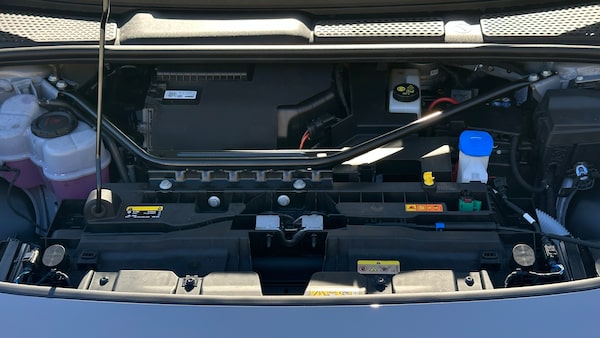
On the Volkswagen ID.7, there is no frunk. The motor is under the hood.Mark Richardson/The Globe and Mail
Performance
Here’s where everything gets subjective. The numbers are ho-hum: 282 horsepower with a claimed acceleration from zero-to-100 kilometres an hour of 6.4 seconds. But the electric motor makes a stupendous amount of instantly available torque – 402 lb-ft – and that makes the car exceptionally responsive at lower city speeds. At highway speeds, it’s very manageable and satisfying in its execution. You won’t want to go to a racetrack, but why would you want to in your family sedan, anyway? It’s no wallowing limousine, and the ID.7 cruises comfortably and quietly at speed on the interstate, and laps up curving roads quickly enough to make your passengers beg for mercy.
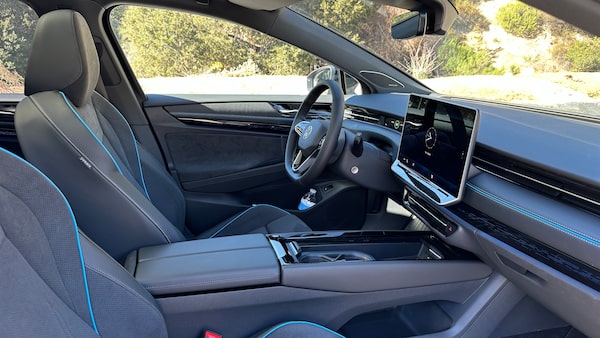
There is a ledge along the bottom of the 15-inch touchscreen for your fingers which makes it easier to use while driving.Mark Richardson/The Globe and Mail
Technology
There are very few actual buttons as we move closer to the Tesla standard of including nothing that gets in the way of a living-room feel. Most everything is controlled through the central 15-inch touchscreen, or through voice control, but there is a fixed ledge along the bottom of the screen for your fingers which makes it easier to use while driving. That’s where you’ll find the slider buttons for cabin temperature and the radio controls.
There’s a small, slim display for the instrument gauges in the dash behind the steering wheel. Volkswagen makes a big deal of the augmented-reality head-up display on the windshield above it, which is a standard feature, but it seemed to me to be similar to Mercedes’ use of HUD real-time navigation and information. I really didn’t notice it but it may have been my polarized sunglasses obscuring the display.
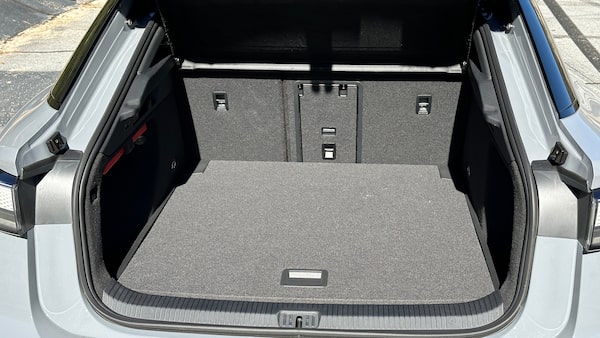
Even though it is called a sedan, the trunk on the Volkswagen ID.7 opens like a hatchback.Mark Richardson/The Globe and Mail
Cargo
The trunk has 532 litres of space, which is a little larger than most conventional sedans. If the rear seats are flat, that space is 1,586 litres. There’s no frunk (front trunk) under the hood – the motor is under there, like a traditional car. In the front, the lack of a driveshaft allows for more space beneath the floating centre console, which is always handy for a bag or a purse.
One of the ID.7′s cleverest features is an optional swivelling tow hitch, which stores out of the way behind the rear bumper and drops into place with the touch of a button. It can tow 1,200 kilograms and carry a load of 75 kilograms, which is ample for a couple of e-bikes on a rack. I’d consider the car for this natty feature alone.
The verdict
The ID.7 is a good-looking electric vehicle that’s very satisfying to drive, but I’ll save judgment on its value until official pricing is released.
Shopping for a new car? Check out the new Globe Drive Build and Price Tool to see the latest discounts, rebates and rates on new cars, trucks and SUVs. Click here to get your price.